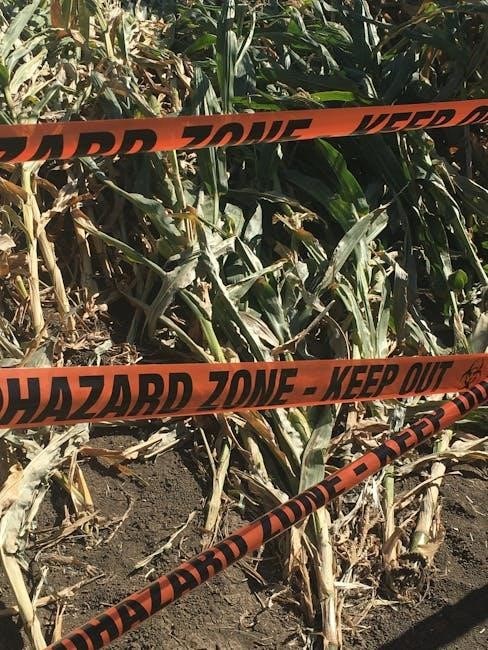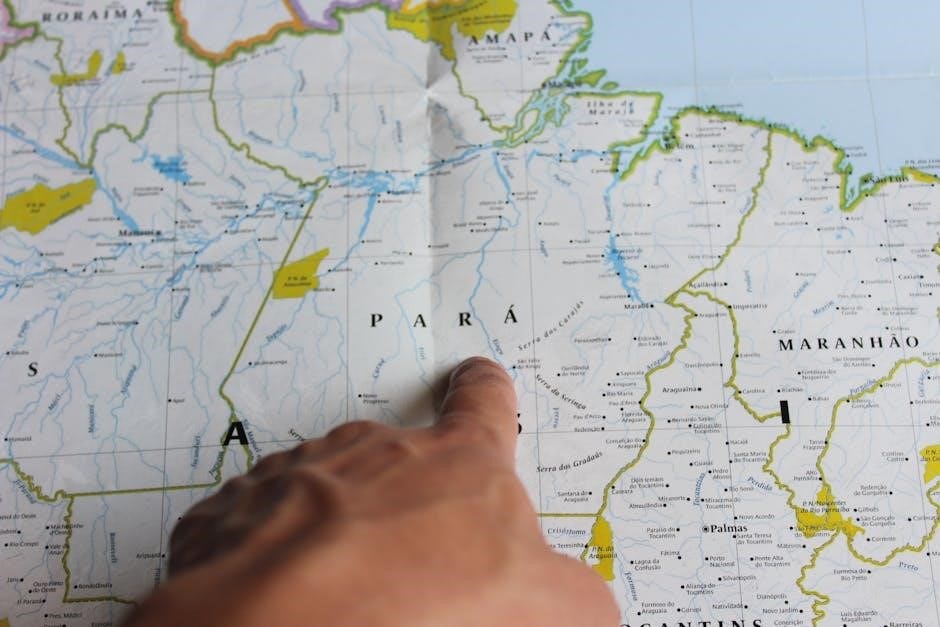Zone 7a offers a moderately long growing season, with average minimum temperatures between 0°F and 10°F. This guide helps gardeners optimize plant selection and timing for success.
1.1 Overview of USDA Hardiness Zone 7a
USDA Hardiness Zone 7a covers areas with average minimum winter temperatures between 0°F and 10°F. This zone enjoys a moderate climate, allowing gardeners to grow a wide variety of plants, including cool- and warm-season crops. The relatively long growing season makes it ideal for multiple harvests, with frost dates typically falling in early spring and late fall.

1.2 Importance of Understanding Your Planting Zone
Understanding your planting zone is essential for successful gardening, as it determines which plants thrive in your area. Zone 7a’s climate guide helps avoid planting mistakes, ensuring plants survive winter and flourish during the growing season. Knowing your zone aids in timing plantings correctly, avoiding frost damage, and selecting varieties suited to your local conditions, leading to healthier plants and higher yields.
Best Plants for Zone 7a
Zone 7a’s temperate climate is perfect for a vibrant mix of vegetables, fruits, flowers, and herbs, offering endless possibilities for gardeners seeking a diverse and thriving garden.
2.1 Vegetables
Zone 7a’s climate supports a wide variety of vegetables, including tomatoes, peppers, cucumbers, and leafy greens. Cool-season crops like carrots and beets thrive in spring and fall. Plant seeds for warm-season crops after the last frost date (around April 15th). Succession planting ensures continuous harvests, while proper soil preparation and care maximize yields in Zone 7a’s moderate growing conditions.
2.2 Fruits
Zone 7a is ideal for growing a variety of fruits, including strawberries, blueberries, raspberries, blackberries, and grapes. Plant strawberries and raspberries in early spring for a summer harvest, while blueberries and grapes thrive when planted in late winter or early spring. Ensure well-drained soil and adequate sunlight for optimal growth. Acidic soil is essential for blueberries, while grapes prefer fertile, well-drained ground. Proper care ensures a bountiful and delicious harvest.
2.3 Flowers
Zone 7a supports vibrant annuals and perennials. Plant roses, sunflowers, and zinnias in spring for summer blooms. Perennials like coneflowers and black-eyed Susans thrive in early spring or fall. Bulbs such as daffodils and tulips should be planted in fall for spring color. Choose flowers suited to your soil type and sunlight conditions to ensure healthy growth and stunning displays throughout the seasons.
2.4 Herbs
Zone 7a is ideal for a variety of herbs. Annuals like basil and cilantro thrive in warm weather, best planted in spring or summer. Perennials such as rosemary and thyme can be planted in early spring or fall, requiring well-drained soil and sunlight. Incorporating perennials into your herb garden ensures year-round flavors and fragrances, enhancing your culinary creations throughout the seasons.
Planting Calendar for Zone 7a
A detailed schedule for Zone 7a gardens, outlining optimal planting times for vegetables, fruits, and flowers based on frost dates and seasonal conditions.
3.1 Spring Planting
In Zone 7a, spring planting begins as early as late February to early March for cool-season crops like broccoli, spinach, and lettuce. The average last spring frost date is around April 15th, after which warm-season crops such as tomatoes and peppers can be safely planted. Soil preparation is key, with compost and fertilizers added to enhance fertility. Start seeds indoors 4-6 weeks before the last frost date for a head start. Raised beds and row covers can extend the growing season. Consider companion planting to deter pests and improve growth. Rotate crops to maintain soil health and prevent disease buildup. This period is ideal for planting bulbs, perennials, and fruit trees, ensuring a vibrant and productive garden throughout the season.
3.2 Summer Planting
Zone 7a’s warm summers allow for thriving heat-tolerant crops like tomatoes, peppers, and squash. Plant warm-season vegetables and flowers after the last spring frost date (around April 15th). Use drip irrigation and mulch to retain moisture and suppress weeds. Succession planting ensures continuous harvests. Shade cloth can protect sensitive plants from intense heat. Regular fertilization and pest monitoring are essential for optimal growth during this productive season.

3.3 Fall Planting
Zone 7a’s first fall frost date averages October 15th, making late summer ideal for planting cool-season crops. Broccoli, kale, spinach, and Brussels sprouts thrive in cooler weather. Start seeds indoors 4-6 weeks before the first frost for a head start. Root vegetables like carrots and beets also excel. Ensure soil is well-prepared with compost and maintain consistent moisture. Succession planting and pest management maximize the fall harvest.
3.4 Winter Planting
Though Zone 7a winters are cool, certain crops can tolerate light frosts. Plant winter-hardy vegetables like kale, spinach, and Brussels sprouts in late fall. Cover crops such as clover or rye protect soil and improve its health. Bare-root trees and shrubs can also be planted during this period. Use cold frames or row covers to extend the growing season for frost-sensitive plants, ensuring a productive winter garden.

Soil Preparation and Care Tips
Test soil pH and amend with compost or manure for fertility. Use balanced fertilizers and maintain organic matter for healthy plant growth and water retention in Zone 7a gardens.
4.1 Soil Requirements for Zone 7a
Zone 7a gardens thrive in well-draining, rich soil with a pH between 6.0 and 7.0. Organic matter like compost enhances soil fertility and structure, promoting healthy root development. Regular testing ensures optimal nutrient levels, while mulching retains moisture and regulates temperature, creating a conducive environment for diverse plant growth throughout the season.
4.2 Composting and Fertilization
Composting adds essential nutrients to Zone 7a soil, improving its structure and fertility. Incorporate organic materials like kitchen scraps and leaves to enrich the soil. Balanced fertilizers, applied seasonally, ensure plants receive necessary nutrients; Regular composting and fertilization promote healthy plant growth, enhancing yields and resistance to pests and diseases, while maintaining soil health for sustainable gardening practices.
Frost Dates and Planting Strategy
Zone 7a has an average last spring frost date of April 15th and first fall frost date of October 15th. Plan planting schedules around these dates to avoid frost damage and optimize growth.
5.1 Average Last Spring Frost Date
Zone 7a experiences an average last spring frost date of April 15th. This critical date guides gardeners in timing seed starting and transplanting outdoors, ensuring plants avoid frost damage. Knowing this date helps optimize planting schedules for vegetables, flowers, and herbs, ensuring a successful growing season. Always consult local frost charts for precise timing, as microclimates can vary slightly;
5.2 Average First Fall Frost Date
Zone 7a typically experiences its first fall frost around October 15th. This date signals the end of the warm-weather growing season, prompting gardeners to harvest remaining crops or protect sensitive plants. Knowing this date is crucial for planning fall plantings and ensuring crops mature before frost. Always check local frost charts, as microclimates can shift dates slightly, affecting planting strategies and harvest timelines.

Using the USDA Plant Hardiness Zone Map
The USDA Plant Hardiness Zone Map divides regions based on average minimum temperatures, helping gardeners select suitable plants and plan planting schedules for their specific zone, like Zone 7a.
6.1 How to Read the Zone Map
The USDA Plant Hardiness Zone Map is color-coded, dividing the country into 13 zones based on average minimum winter temperatures. Each zone is further split into 5°F increments (a and b). Gardeners can locate their specific zone by referencing their area on the map, which helps determine which plants are most likely to thrive in their region, including Zone 7a.
6.2 Adjusting for Microclimates

Microclimates, such as urban heat islands or shaded areas, can alter local conditions beyond the USDA zone. Gardeners in Zone 7a should observe their specific microclimate to adjust planting strategies, ensuring plants suited to their exact environment thrive. This localized approach enhances gardening success by accounting for temperature variations not reflected on the broader zone map.

Extending the Growing Season
Techniques like starting seeds indoors, using cold frames, and employing row covers can extend the growing season. Protecting plants from frost helps maximize yield and enjoy crops longer.
7.1 Techniques for Early and Late Planting
Early planting in Zone 7a involves starting seeds indoors 4-6 weeks before the last frost date. Utilize cold frames, hoop houses, or row covers to protect crops from frost. Late planting focuses on selecting varieties with shorter maturity dates, ensuring harvest before the first fall frost. Proper soil preparation and timely fertilization enhance success in both seasons.
7.2 Protecting Plants from Frost
Protecting plants from frost in Zone 7a involves using row covers, bringing potted plants indoors, or installing cold frames. Watering plants before frost can create a protective ice layer. Harvesting sensitive crops before frost or applying mulch also helps preserve plant health. These strategies ensure plants survive temperature drops and thrive during the growing season.
Common Challenges in Zone 7a
Zone 7a gardeners face temperature fluctuations, pests, and diseases. Managing these issues requires tailored strategies, ensuring plant health and a productive garden throughout the seasons.
8.1 Dealing with Temperature Fluctuations
Zone 7a gardeners must adapt to temperature swings, with average lows between 0°F and 10°F. Protect plants from frost using row covers or cold frames, especially for tender crops. Monitor weather forecasts to avoid planting during extreme cold snaps. Hardy perennials and cool-season crops like broccoli and kale thrive in these conditions, while sensitive plants may require additional protection or delayed planting.
8.2 Managing Pests and Diseases
In Zone 7a, common pests like aphids, slugs, and snails can damage plants. Regular monitoring and organic controls, such as neem oil or insecticidal soap, are effective. Fungal diseases thrive in humidity, so ensure good air circulation and avoid overwatering. Crop rotation and companion planting can also help prevent infestations. Early detection and treatment are key to maintaining healthy, productive plants throughout the growing season.
Zone 7a offers a moderate climate with four distinct seasons, making it ideal for diverse gardening. By following this guide, gardeners can enjoy a thriving, productive garden year-round.
9.1 Summary of Key Points
Zone 7a has a moderate climate with average temperatures between 0°F and 10°F. Gardeners can grow a variety of plants, including vegetables, fruits, flowers, and herbs. The growing season is long enough for most crops to mature. Planting schedules should consider spring and fall frost dates. Soil preparation and proper care are essential for optimal growth. By following this guide, gardeners can maximize their yield and enjoy a successful gardening experience.
9.2 Encouragement for Gardeners
Gardening in Zone 7a offers immense rewards, with its moderate climate and long growing season. Whether you’re a seasoned gardener or just starting, the variety of plants you can grow ensures a fulfilling experience. Embrace the opportunity to experiment with new species and enjoy the satisfaction of nurturing your garden. Happy gardening!

Additional Resources
Explore USDA Plant Hardiness Zone Maps, planting charts, and gardening tools for Zone 7a. Utilize seed starting guides and frost date calculators for optimal garden planning and success.
10.1 Recommended Gardening Tools
Essential tools for Zone 7a gardening include a soil tiller, compost bin, drip irrigation system, and gloves. Invest in a frost blanket for winter protection and pruning shears for precise cuts. A garden cart or wheelbarrow helps transport plants and supplies efficiently. Use a planting calendar and zone-specific guides to plan effectively. These tools enhance productivity and ensure optimal care for your Zone 7a garden throughout the year.
10.2 Suggested Reading and Guides
Downloadable planting calendars and zone-specific PDF guides provide detailed timelines for Zone 7a. Websites like Kellogg Garden offer charts for sowing, planting, and harvesting. Books on regional gardening and USDA zone maps are invaluable resources. These materials help gardeners plan effectively, ensuring optimal growth and productivity throughout the year in Zone 7a’s unique climate conditions.
